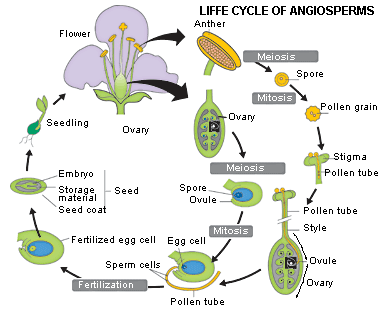Life cycles
The sequence of adult individual, sexual cells, fertilization, embryo, autonomous young organism and again adult individual is called the life cycle. All those basal steps of the life cycle are encountered in plants as well as in animals and humans.
| Life cycle of higher plants and man |
 |
Cells of adult individuals carry two samples of each chromosome, thus a double set (they are sometimes also indicated with "2n" and the term diploid). Male reproductive cells (in plants transported by pollen grains) and female reproductive cells bear only one set of chromosomes (sometimes named as "1n", so-called haploïde cells). The special division leading to the formation of 1n cells from 2n cells is called meiosis (more about
Cell cycle and meiosis.). During fertilization one 1n male sex cell (a sperm cell) fuses with a 1n female sex cell (the egg cell), whereby the result is a normal 2n cell (the zygote).
The essential difference between the life cycle of plants and that of animals or man regards the formation of sex cells: in the sexual reproductive organs of adult animals or humans meiotic divisions directly to the formation of (1n) reproductive cells. In plants, however, there is an intermediate stage; meiosis leads in the adult parent plant (also called 'sporophyte' and consisting of 2n cells) to the formation of (1n) spores that develop into a gametophyte which only later will produce reproductive cells. All plants undergo alternation of generation, namely a sporophytic and a gametophytic generation. The large flowering plants that we see in the fields are always sporophytes.
The role of pollen in the life cycle of plants
The formation of male spores occurs in flowering plants (Angiosperms) in the anthers, a part of the stamina, and in Gymnosperms in separate male cones. The formation of female spores happens in flowering plants in the ovules, a part of the pistil, and in Gymnosperms in special female cones (more about
flowers and cones and about
pollen development). The 1n gametophytes that arise from (1n) spores through normal (mitotic) divisions, are in fact minuscule individual plants: the pollen grains at the male side and the embryo sac at the female side. Through further divisions the true gametes are formed in the pollen and in the embryo sac: respectively the sperm cells and the egg cell. In the overall immobile plant, by 'traveling' the pollen grains transport the male sex cells to the egg cell, enabling fertilization.
Pollen grains fulfil thus an essential role in the reproduction of all seed plants, as well in Gymnosperms as Angiosperms. Spore plants like mosses and ferns do not produce pollen; they disperse their spores through the air. When the spores comeon the soil they can then germinate and grow to a free-living, green gametophyte (see: life cycle of a
moss and a
fern).
Angioperms
During reproduction of flowering plants first spores are produced with half the number of chromosomes in their cell nuclei. The male spores lead to the formation of pollen grains in which the sperm cells arise. After fertilization a young embryo with again the same number of chromosomes as the parental plants develops in the ovule (more on
fertilization in Angiosperms).
Gymnosperms
Male and female cones develop on the mature sporophyte (the tree). Meiosis in the ovules of the female cones leads to the formation of female gametophytes, the embryo sacs containing each one egg. The male cone consists of scale that carry each a pollen sac in which pollen grains are produces through meiotic division. After bursting of the pollen sacs pollen grains are dispersed and can reach the female cone through the air. There a pollen tube can grow in which the sperm cells migrate tot the egg cell, ending in fertilization. An embryo is thus formed that ususally needs several years to develop into a complete seed that once on the soil will be able to germinate and to grow to a new sporophyte.
| Life cycle of Angiosperms and Gymnosperms |
| Angiosperms (Flowering plants) | Gymnosperms
Click on the thumbnails here below for microscopical views with explanations |
 |

|
Webpages and photographs:Jan Derksen and Elisabeth Pierson
Drawings: Lidwien van der Horst and John Slippens
Web development: Remco Aalbers







